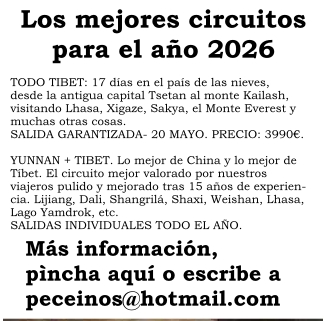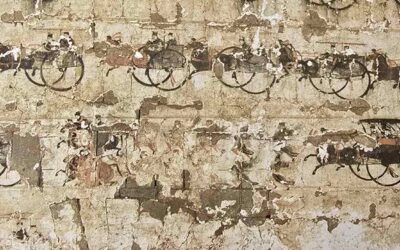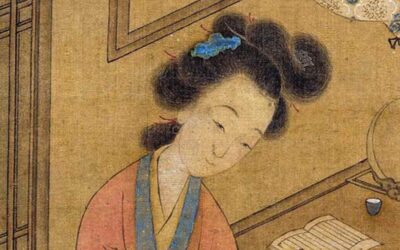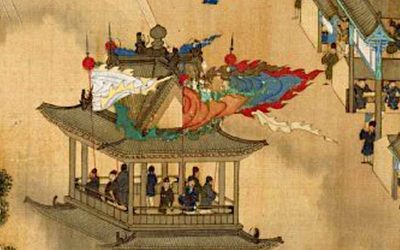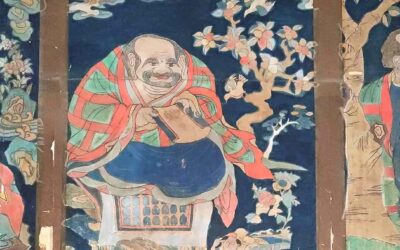On the left side was a densely wooded rocky hill. Its steep slope was carved into fantastic figures of unicorns, leogryphs and other mythological animals, and statues of gods and saints. They had been fashioned out of rock by the monks more than fifteen centuries ago. Under the hill were grottoes and caves filled with Buddhas and genii, where pilgrims were burning incense. Mantras in Sanskrit and archaic Chinese adorned the rocks, chiselled by the long departed hermits.]
Walking a little farther we came to the spacious entrance hall of a monastery which was unique in China in its grandeur, sanctity.
‘The Monastery of the Spirit’s Retreat’, softly exclaimed Chungan pointing to the three huge golden characters over the wide-open doors of the hall.
‘What a deep and secret meaning these words possess ! ‘ he continued. ‘It is a fitting name for this place, for it is difficult to conceive a better hermitage for the spirit of a man tired of the world and seeking concealment amidst the beautiful and tranquil.
Having emerged from this hall with its golden statue of Maitreya, the Lord Buddha of the Future, we stepped out into a large stone-flagged courtyard bounded by ancient trees. In front of them, on a high stone platform, flanked by two small pagodas and with a massive bronze incense burner in the middle, stood the main temple hall. its great height and immense size dwarfed all other buildings around it. The roof rose in three nobly curved tiers supported by colossal red wooden pillars.
The latticed gates of the hall were open as we came in. A mysterious semi-darkness, heavy with the odour of sandal-wood incense, pervaded the place. Right in the middle of the vast temple sat three golden Buddhas of such unbelievable majesty and of such gigantic proportions that when I saw them I was astonished. The images rested on lotus flowers which, in turn, were supported by stupendous stone pedestals. A colossal lantern, richly carved and decorated, with a perpetually-burning oil-lamp within, was suspended in front of the Trinity.
The central figure was that of the Lord Buddha himself with his royal coiffure and a sign of urna on his forehead. With the eyes turned inwards, gazing not at the world outside before him but at the world within himself; with his enigmatic smile, he sat there a true image of the man that he once was, but who had transcended all human emotions, desires, all suffering and mundane joy; who had found the lost path to Heaven and shown it to suffering mankind, and who at last had entered Nirvana and became himself a God. I gazed enchanted at the mystic statue. I felt mesmerized by the utter stillness of the temple. Clouds of incense floated in spirals towards the lofty ceiling and gently dissolved there in the golden rays of the sun coming through the narrow windows. The very silence was pregnant with the meaning of things unsaid, of prayers uttered and of petitions yet unoffered.
After we had finished our tour of the golden statues of arhats, lining the walls, and paused before an enormous image of the gentle Goddess Kwanyin, which stood against an altar piece representing the Western Paradise, we made our exit by a side door into a commodious guest hall where a young novice brought us cups of the monastery’s own tea. He smiled at Chungan and Tsungpoo, evidently recognizing them as frequent visitors. After a good rest we were ready to proceed to the next famous temple.
Goullart, Peter. Monastery of the Jade Mountain.
Peter Goullart. The monastery of Jade Mountain.
More posts on Chinese culture
Descubre el mayor y más bello lago salado de China
Descubre el mayor y más bello lago salado de China El desarrollo del turismo y de las comunicaciones en China está sacando al mercado lugares antes de muy difícil acceso y prácticamente desconocidos. Algunos están empezando a tomar cierto renombre, al menos entre las...
Un gigantesco mandala en el corazón del Tibet
Un gigantesco mandala en el corazón del Tibet. El Palkor de Gyantze es una de las maravillas de Tíbet y una joya única de la arquitectura y arte universal. Su forma, tamaño e iconografía no admiten comparación con otras construcciones. En medio de algunas de las...
La mayor colección de pinturas de China de hace dos mil años
La mayor colección de pinturas de China de hace dos mil años Nadie duda de que en China existió un arte pictórico desde tiempo inmemorial. De hecho, algunas vasijas de cerámica pintadas, con una antigüedad de varios miles de años, siguen despertando la curiosidad de...
La situación real de las mujeres en la dinastía Qing
La situación real de las mujeres en la dinastía Qing Guo Songyi[1] ha planteado varios puntos importantes sobre la situación de las mujeres chinas durante la dinastía Qing; observaciones que podrían cambiar profundamente la manera en que tanto el público como los...
La madre de Laozi es la diosa creadora del taoísmo
La madre de Laozi es la diosa creadora del taoísmo En el pensamiento taoísta, los grandes misterios no se explican con declaraciones tajantes, sino con imágenes paradójicas, mitos fragmentarios y metáforas corporales. Uno de esos misterios es el origen del mundo, y...
Una historia de detectives entre la nacionalidad dai de China
Una historia de detectives entre la nacionalidad dai de China Entre la rica literatura popular de la nacionalidad dai, que habita en las fronteras sur y occidental de la provincia de Yunnan, principalmente en las prefecturas autónomas de Xishuangbanna y Dehong, los...
More posts on China ethnic groups
Descubre el mayor y más bello lago salado de China
Descubre el mayor y más bello lago salado de China El desarrollo del turismo y de las comunicaciones en China está sacando al mercado lugares antes de muy difícil acceso y prácticamente desconocidos. Algunos están empezando a tomar cierto renombre, al menos entre las...
Un gigantesco mandala en el corazón del Tibet
Un gigantesco mandala en el corazón del Tibet. El Palkor de Gyantze es una de las maravillas de Tíbet y una joya única de la arquitectura y arte universal. Su forma, tamaño e iconografía no admiten comparación con otras construcciones. En medio de algunas de las...
La mayor colección de pinturas de China de hace dos mil años
La mayor colección de pinturas de China de hace dos mil años Nadie duda de que en China existió un arte pictórico desde tiempo inmemorial. De hecho, algunas vasijas de cerámica pintadas, con una antigüedad de varios miles de años, siguen despertando la curiosidad de...
La situación real de las mujeres en la dinastía Qing
La situación real de las mujeres en la dinastía Qing Guo Songyi[1] ha planteado varios puntos importantes sobre la situación de las mujeres chinas durante la dinastía Qing; observaciones que podrían cambiar profundamente la manera en que tanto el público como los...
La madre de Laozi es la diosa creadora del taoísmo
La madre de Laozi es la diosa creadora del taoísmo En el pensamiento taoísta, los grandes misterios no se explican con declaraciones tajantes, sino con imágenes paradójicas, mitos fragmentarios y metáforas corporales. Uno de esos misterios es el origen del mundo, y...
Una historia de detectives entre la nacionalidad dai de China
Una historia de detectives entre la nacionalidad dai de China Entre la rica literatura popular de la nacionalidad dai, que habita en las fronteras sur y occidental de la provincia de Yunnan, principalmente en las prefecturas autónomas de Xishuangbanna y Dehong, los...

